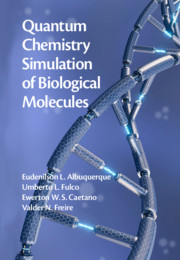Book contents
- Frontmatter
- Contents
- Preface
- Figure Credits
- 1 Basic Properties of Quantum Chemistry
- 2 Charge Transport in the DNA Molecule
- 3 Electronic Transmission Spectra of the DNA Molecule
- 4 Thermodynamic Properties of the DNA Molecule
- 5 Properties of the DNA/RNA Nucleobases
- 6 Molecular Electronics
- 7 Amino Acid Anhydrous Crystals
- 8 Protein–Protein Systems
- 9 Ascorbic Acid and Ibuprofen Drugs
- 10 Cholesterol-Lowering Drugs
- 11 Collagen-Based Biomaterials
- 12 Antimigraine Drugs
- 13 Antiparkinson Drugs
- 14 Central Nervous System Disorders
- 15 The Biology of Cancer
- 16 Concluding Remarks
- Bibliography
- Index
10 - Cholesterol-Lowering Drugs
Published online by Cambridge University Press: 21 January 2021
- Frontmatter
- Contents
- Preface
- Figure Credits
- 1 Basic Properties of Quantum Chemistry
- 2 Charge Transport in the DNA Molecule
- 3 Electronic Transmission Spectra of the DNA Molecule
- 4 Thermodynamic Properties of the DNA Molecule
- 5 Properties of the DNA/RNA Nucleobases
- 6 Molecular Electronics
- 7 Amino Acid Anhydrous Crystals
- 8 Protein–Protein Systems
- 9 Ascorbic Acid and Ibuprofen Drugs
- 10 Cholesterol-Lowering Drugs
- 11 Collagen-Based Biomaterials
- 12 Antimigraine Drugs
- 13 Antiparkinson Drugs
- 14 Central Nervous System Disorders
- 15 The Biology of Cancer
- 16 Concluding Remarks
- Bibliography
- Index
Summary
Considering the crystallographic data of the Human HMG-CoA reductase (HMGR) complexed with statins, a quantum chemistry study, based on the density functional theory, is performed to estimate the interaction energy for each statin, when one considers binding pockets of different sizes, based solely on the interpretation of crystallographic data of the HMGR–statin complex. Assuming a correlation between the statin potency and the strength of the HMGR–statin binding energies, clinical data of these cholesterol-lowering drugs are successfully explained after stabilization of the calculated binding energy for a larger size of the ligand-interacting HMGR region. The statins atorvastatin and rosuvastatin are shown to be the most strongly bound HMGR inhibitors, while simvastatin and fluvastatin are the weakest ones. An accurate description of the residue–ligand interaction energies at the binding site suggests a quantum chemistry–based route for the development of new statin derivatives.
Keywords
- Type
- Chapter
- Information
- Quantum Chemistry Simulation of Biological Molecules , pp. 233 - 248Publisher: Cambridge University PressPrint publication year: 2021

